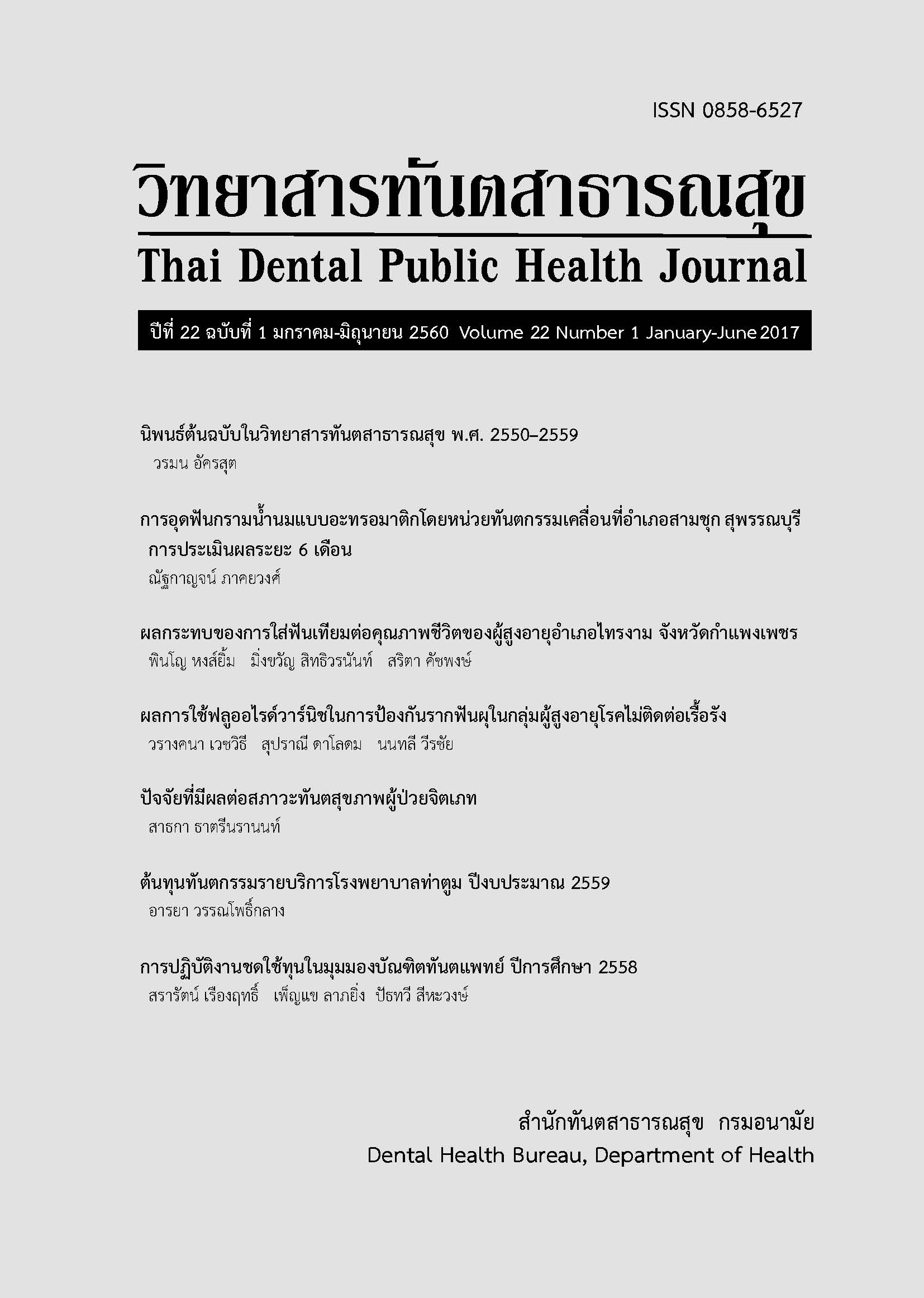The effect of fluoride varnish on root carious lesions in older adults with non-communicable diseases.
Main Article Content
Abstract
The purpose of this quasi-experimental research was to determine the effect of fluoride varnish in arresting root carious lesions in 203 functionally-independent older adults with non-communicable diseases which randomly into 3 groups. The control group received professional tooth cleaning with non-fluoride-containing paste every 3 months. The 2 study groups were applied with fluoride varnish at baseline and repeatedly every 3 and 6 months. All subjects were practiced tooth brushing with fluoride toothpaste at baseline, 6th, 12th, 18th, 24th and 30th month. The numbers of primary root carious lesions or leathery, softened, arrested and filled root surfaces were clinically recorded and analyzed with Chi-square and Kruskal Wallis test. At 6th month, the number of root caries-arrested surfaces in the groups applied fluoride every 3 and 6 months were rapidly increased 36.5% and 52.8% respectively which had significant difference with 15.4% increasing of the control group. This difference was found at every root-examination throughout the study at 30th month. Fluoride varnish could arrest active root caries at 6th month after varnish application and continued until 30th month. Therefore, dental personnel should be advocated to provide every 6 month-application which the result was not different with every 3 month-application.
Downloads
Article Details
References
2. Galan D, Lynch E. Epidemiology of root caries. Gerodontology 1993; 10:59-71.
3. Banting DW. The diagnosis of Root Caries. J of Dental Education 2001; 65: 991-96.
4. Boehm TK, Scannapieco FA. The Epidemiology, Consequences and Management of Periodontal Disease in Older Adults. J Am Dent Assoc 2007; 138 (Suppl1):26s-33s.
5. Thomson WM. Dental caries experience in older people over time: what can the large cohort studies tell us? British Dental Journal 2004; 196:89-92.
6. Paraskevas S, Danser MM, Timmerman MF, van der Velden U, van der Weijden GA. Amine fluoride/stannous fluoride and incidence of root caries in periodontal maintenance patients. J Clin Periodontal 2004; 31:965-71.
7. Beighton D, Lynch E. Comparison of selected microflora of plaque and underlying carious dentine associated with primary root caries lesions. Caries Res 1995; 29:154-8.
8. Taylor M J, Lynch E. Microleakage. J Dent 1992; 20:3-10.
9. Department of health. Survey report on the health status of the Thai elderly B.E. 2556. Health promotion for the elderly and disability plan, Nonthaburi: Watcharin P.P.; 2013. (in Thai)
10. Hintao J, Teanpaisan R, Chongsuvivatwong V, Dahlen G, Rattarasarn C. Root surface and coronal caries in adults with type 2 diabetes mellitus. Community Dent Oral Epidemiol 2007; 35:302-9.
11. Lin BP, Taylor GW, Allen DJ, Ship JA. Dental caries in older adults with diabetes mellitus. Spec Care Dentist 1999; 19:8-14.
12. Garton BJ. Ford PJ. Root caries and diabetes: risk assessing to improve oral and systemic health Outcomes. Australian Dental Journal 2012; 57:114–22.
13. Sandberg GE, Sundberg HE, Fjellstrom CA, Wickblad KF. Type 2 diabetes and oral health: A comparison between diabetic and non-diabetic subjects. Diabetes Res Clin Pract 2000; 50: 27-34.
14. Hintao J, Teanpaisan R, Chongsuvivatwong V, Rattarasarn C, Dahlen G. The microbiological profiles of saliva, supragingival and subgingival plaque and dental caries in adults with and without type 2 diabetes mellitus. Oral Microbiol Immunol 2007; 22:175-178.
15. Popescu SM, Scrieciu M, Mercut V, Tuculina V, Dascălu I. Hypertensive Patients and Their Management in Dentistry: Review Article. ISRN Hypertension 2013, Article ID 410740 Available from:URL: http://dx.doi.org/10.5402/2013/4107407
16. Allen EP, Bayne SC, Brodine AH, Cronin RJ Jr, Donovan TE, Kois JC, Summitt JB. Annual review of selected dental literature: Report of the Committee on scientific investigation of the American Academy of Restorative Dentistry. J Prosth Dent 1999; 83:27-66.
17. Nyvad B, Fejerskov O. Active root surface caries converted into inactive caries as a response to oral hygiene. Scand J Dent Res 1986;94:281-4.
18. Lynch E, Baysan A. Reversal of primary root caries using a dentifrices with a high fluoride content. Caries Res 2001; 35:60-4.
19. Baysan A, Lynch E, Ellwood R, Davies R, Petersson L, Borsboom P. Reversal of primary root caries using dentifrices containing 5,000 and 1,100 ppm fluoride. Caries Res 2001; 35:41-6.
20. Gluzman R, Katz RV, Frey BJ, McGowan R. Prevention of root caries: A Literature Review of Primary and Secondary Preventive Agents. Spec Care Dentist 2013; 33:133-40.
21. American Dental Association Council on Scientific Affairs. Professionally applied topical fluoride: Evidence-based clinical recommendations. JADA 2006; 137:1151-9.
22. Davies GM and Davies RM. A New Look at Fluoride Varnishes. Dental Update 2004; 31:351-4.
23. Public Health England. Increasing fluoride availability in Delivering better oral health: An evidence-based toolkit for prevention. London: Department of Health/ National Health Service/ British Association for the Study of Community Dentistry; 2014. Available from:URL https://www.gov.uk/government/uploads/system/uploads/attachment_data/file/605266Delivering_better_oral_health.pdf
24. Ekstrand K, Martignon S and Holm-Pedersen P. Development and evaluationof two root caries controlling programmes for home-based frail people older than 75 years. Gerodontology 2008; 25:67-75.
25. Tan HP, Lo EC, Dyson JE, Luo Y, Corbet EF. A randomized trial on root caries prevention in elders. J Dent Res 2010; 89:1086–90.
26. Emilson CG, Ravald N, Birkhed D. Effects of a 12-month prophylactic program on selected oral bacterial populations on root surfaces with active and inactive carious lesions. Caries Res 1993; 27:195-200.
27. Schaeken MJ, Keltjens HM, Van Der Hoeven JS. Effects of fluoride and chlorhexidine on the microflora of dental root surfaces and progression of root-surface caries. J Dent Res 1991; 70:150-3.
28. Berry TG, Summitt JB, Sift EJ Jr. Root caries. Oper Dent 2004; 29:601-7.


